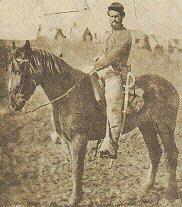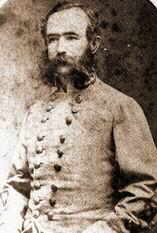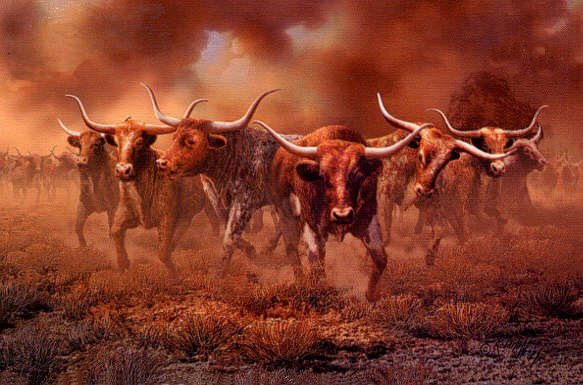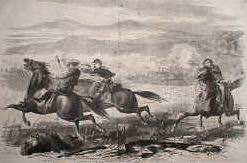Wade Hampton
and
The Great Beefsteak Raid
|
By September 1864, the Union siege of Petersburg was entering its third month. As Gen. Ulysses S. Grant's Army of the Potomac leap-frogged westward, it began cutting road and rail supply lines; tightening the noose around Gen. Robert E. Lee's Army of Northern Virginia, which was guarding the city. South of Petersburg, away from the main battle lines, the country was the setting for ugly guerrilla warfare. Confederate cavalry ranged deep behind the lines, regularly raiding isolated Union posts. Spies from both sides roamed the land gathering information, looking for weaknesses.
|
|
|
|
Sgt. George D. Shadburne of the Jeff Davis Legion was listed, officially at least, as a scout for the Rebel cavalry. The Yankees called him an outlaw. Whatever his profession, on Sept. 5, 1864, Shadburne submitted a thorough report of the Union defenses east of Petersburg as far as Coggin's Point on the James River. Besides outlaying the position and strength of Federal forces in the area, Shadburne also pointedly mentioned that at Coggin's Point was a corral containing 3,000 head of cattle intended for Grant's army. These meals on the hoof were guarded by only 120 men and 30 unarmed civilians.
|
The recipient of the report was Maj. Gen. Wade Hampton, who had been given command of Lee's cavalry arm after the death of J.E.B. Stuart in May 1864. Apparently Stuart's fondness of riding around invading Union armies rubbed off on Hampton, as the latter immediately began planning a way to relieve the Yankees of their cattle. Hampton's plan involved the division of Maj. Gen. William H.F. "Rooney" Lee, the brigades of Rosser and Dearing, as well as 100 men from Young's and Dunovant's brigades.
Stepping off on the morning of the 14th, Hampton's force headed south on the Boydton Plank Road (See Map). Reaching Stoney Creek, they turned southeast and headed toward Wilkinson's bridge on Rowanty Creek where they bivouacked that night. Leaving early on the 15th they marched at a quick pace to Cooke's Bridge on the Blackwater.
|
|
|
Cooke's Bridge had been destroyed by the Yankees, which was precisly why Hampton chose it. Hampton correctly surmised that the Federals would not expect him to use that route. As his engineers repaired the bridge, Hampton's troopers rested and watered their mounts. Just after midnight, they moved northward toward Coggin's Point. Having gotten within 10 miles of their objective undetected, Hampton divided his command into three parts.
The smallest force, under Dearing, would take up a blocking position at Cocke's Mill to guard against any Yankee interference from the east. The largest unit, Rooney Lee's, would scatter the Yankees camped around Prince George's Court House and guard against any probes from the west. The last column, Rosser and Miller, would move north and capture the cattle herd.
By 5 a.m., all three columns were in position and the attack commenced. Rosser hit first and, after a spirited Federal defense, captured the Yankee camp and liberated the cattle. Lee on the left and Dearing on the right both took their blocking positions successfully. Collecting 2,486 cattle, Hampton's three columns broke off their attack three hours later and headed back to Cooke's Bridge on the Blackwater.
(See Map)
After crossing the Blackwater, Hampton sent Rosser on ahead to hold the Jerusalem Plank Road at Ebenezer Church.
Scouting northward up the road, Rosser soon detected a Federal force of 2,100 troopers under Brig. Gen. Henry Davies, Jr. approaching the church. Reinforced by Miller, Rosser easily held off the Federals until well after dark as the cattle crossed two miles behind them. As the Federals fell back, Hampton left four squadrons on picket at the church and moved the rest of his command to their former camp on the Rowanty and stopped for the night. The raid encountered no further interference from the Yankees and the raiders rode into Confederate lines the next day.
|
In his after-action report, Hampton wrote: "the command returned to their old quarters after an absence of three days, during which they had marched upward of 100 miles, defeating the enemy in two fights, and bringing from his lines in safety a large amount of captured property, together with 304 prisoners. Of the 2,486 cattle captured 2,468 have been brought in, and I hope [to] get the few remaining ones. Three guidons were taken and eleven wagons brought in safely, several others having been destroyed. Three camps of the enemy were burned, after securing from them some very valuable stores, including quite a number of blankets. My loss was 10 killed, 47 wounded, and 4 missing."
HOME
About SCV -
Join SCV -
Legionary -
Co. News -
Education -
Ancestors
Memorials -
Links -
Guest Book
|



